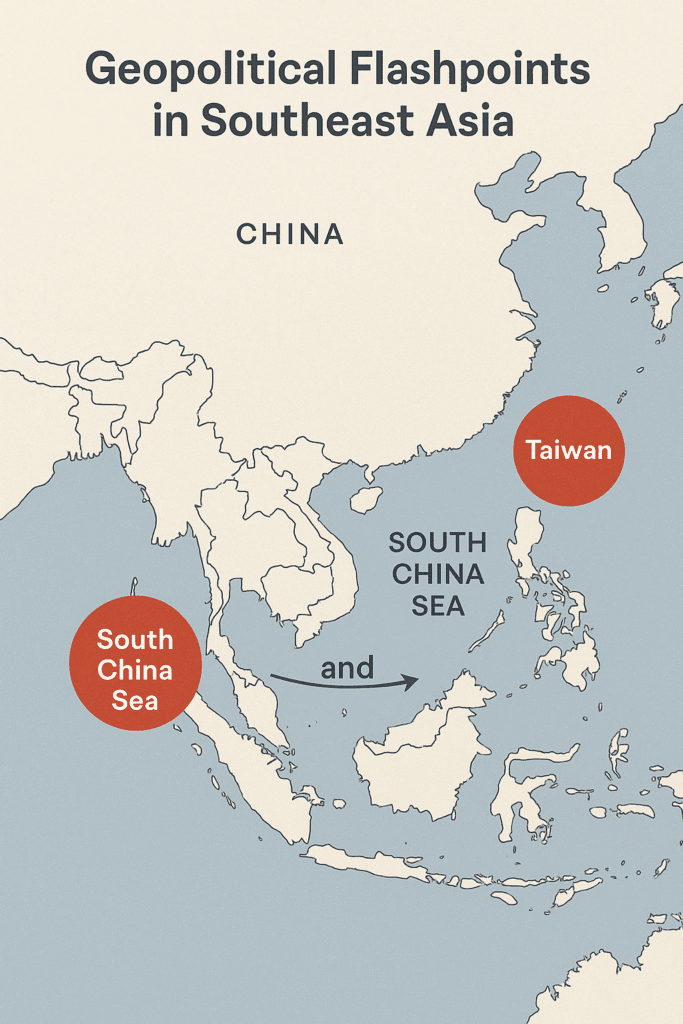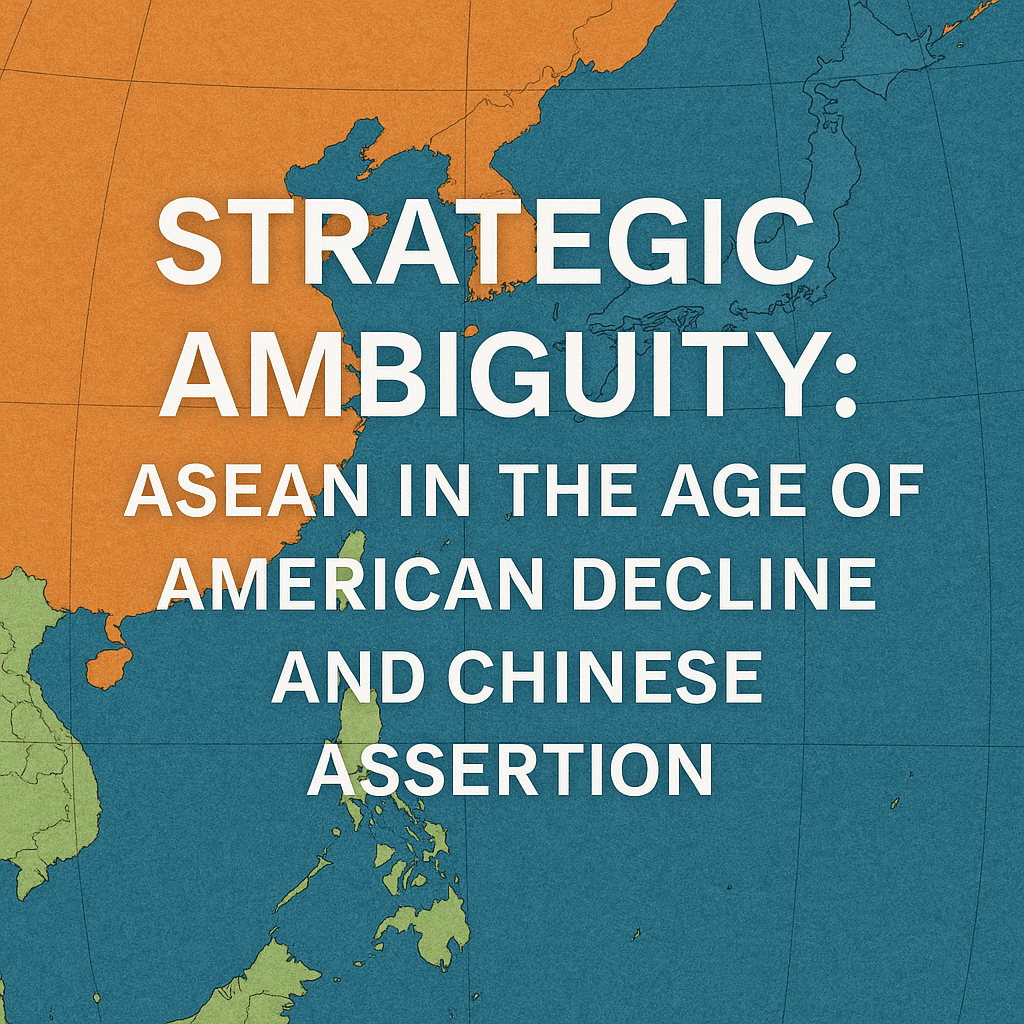ASEAN Between the U.S. and China: The Future of Strategic Ambiguity
As global power fractures and the U.S.–China rivalry deepens, Southeast Asia faces mounting pressure to choose sides. At the heart of its diplomatic posture lies ASEAN strategic ambiguity — a deliberate stance of non-alignment that has allowed the region to avoid direct confrontation, leverage competing powers, and preserve a measure of autonomy. Yet in an era marked by digital warfare, economic coercion, and climate instability, that ambiguous middle ground is rapidly eroding.
This essay examines whether ASEAN’s longstanding doctrine of neutrality can survive the geopolitical storms ahead — or whether a new regional identity must emerge.
ASEAN Strategic Ambiguity Diplomacy: The New Era
In Southeast Asia, clarity is a liability. Ambiguity is an art.
From Vietnam’s embrace of American aircraft carriers to Cambodia’s deepening ties with China, ASEAN nations are navigating the currents of power not through alignment, but through calculation. The region’s survival has long depended on its refusal to choose — on its mastery of the in-between.
But the space between is collapsing.
As the United States faces internal fragility and global fatigue, and as China accelerates its territorial, economic, and digital expansion, ASEAN’s time-tested strategy of hedging is under pressure. The world is no longer bipolar, nor truly multipolar — it is unstable, asymmetrical, and fragmented. And strategic ambiguity, while elegant, may no longer be sufficient.
The Crumbling Pillars of Pax Americana
There was a time when the American security umbrella offered Southeast Asia room to grow, dissent, and dream. But that umbrella is tattered.
From Iraq to Kabul, Washington has hemorrhaged credibility. Trump’s transactional withdrawalism, followed by Biden’s cautious recalibration, left the region wondering whether U.S. presence is sustainable or simply habitual. The much-touted “Indo-Pacific Strategy” reads more like a patchwork of tactical responses than a coherent vision.

The U.S. maintains military access, yet has no substantial economic alternative to China’s Belt and Road. It speaks the language of democracy, yet tolerates strongmen. It preaches digital freedom, yet lags in digital infrastructure.
“The U.S. sends carriers, not consensus.”
And ASEAN, for all its quietism, listens more to action than intention.
The Chinese Assertion Machine
If America has stumbled, China has marched — deliberately, unevenly, but persistently.
Beijing’s strategy is layered: build influence through trade and infrastructure, erode resistance through dependency, and normalize its dominance through proximity. The South China Sea is not just a territorial claim — it is a demonstration of narrative control. Lawfare, coercive diplomacy, and maritime militia presence form a web of constant pressure.
Belt and Road projects across Laos, Cambodia, and Indonesia reveal the “bind-then-define” method: wrap nations in soft loans, then shape the regional vocabulary of development, debt, and sovereignty.
Digital sovereignty is Beijing’s next frontier — Huawei’s infrastructure, TikTok’s influence, and data colonialism are not afterthoughts. They are the new Silk Road: algorithmic, invisible, persuasive.

ASEAN’s Hedging Doctrine
ASEAN has never been monolithic. Its unity is procedural, not ideological. But its shared logic has been clear: never provoke a giant, never depend on one.
That logic, however, is diverging under pressure:
- Vietnam deepens defense ties with the U.S. while retaining economic entanglement with China.
- Singapore plays both fund manager and digital referee, hosting American think tanks and Chinese fintech alike.
- Indonesia asserts autonomy through ambiguity, aspiring to moral leadership without intervention.
- Cambodia appears increasingly clientelized under China’s orbit.
- The Philippines, once pivoted to China under Duterte, now returns to the American fold under Marcos Jr.
At the institutional level, ASEAN continues to emphasize “centrality.” But without real enforcement mechanisms or unified strategic ambition, this centrality risks becoming ceremonial.
“Ambiguity only works when the great powers tolerate your uncertainty.”
The tolerance is thinning.
Fault Lines and Futures
The tectonics beneath ASEAN are shifting. And the cracks are showing.
- South China Sea tensions remain a combustible flashpoint.
- The Taiwan crisis, though geographically distant, could trigger devastating economic and military spillover.
- Cybersecurity, digital authoritarianism, and AI governance are emerging as frontiers where neither the U.S. nor China offer neutral models.
- Climate insecurity, particularly in the Mekong region, is accelerating migration and resource competition — with little regional coordination.
ASEAN is being tested not just as a diplomatic mechanism, but as a concept:
Can a region survive on ambiguity in an era of collapse?

Toward a New Strategic Identity
What ASEAN lacks in military heft, it makes up for in narrative potential.
Rather than being pulled between great powers, Southeast Asia could position itself as a Third Pole — not through confrontation, but through constructive divergence.
Imagine:
- A digital non-alignment movement: regional data sovereignty independent of Western or Chinese platforms.
- Cross-border city alliances: Hanoi, Jakarta, and Kuala Lumpur co-developing regional AI and climate policies.
- Cultural diplomacy as strategic infrastructure: shared Southeast Asian narratives challenging the binaries of East vs West.
To do so, ASEAN must move beyond procedural neutrality and embrace strategic imagination.
Conclusion: The End of the In-Between?
Southeast Asia has mastered the art of survival between giants. But the in-between is narrowing.
Strategic ambiguity was once a shield.
It may soon become a trap.
ASEAN does not need to choose sides.
But it must choose its future.
Bonus: Indicators to Watch (2025–2030)
- Vietnam–U.S. defense agreements: Expansion into joint drills, arms tech, or intelligence-sharing will mark a new phase of alignment.
- The Philippines’ base access to the U.S.: A litmus test for regional tolerance of American military re-engagement.
- Cambodia’s internal digital firewall: Whether it mirrors China’s model could reveal the deepening of soft-authoritarian dependencies.
- Indonesia’s “middle power” play: Watch for moves in AI governance, BRICS relations, and non-dollar trade initiatives.
- Mekong River governance: Environmental diplomacy will either become ASEAN’s Achilles’ heel or its reinvention point.
- ASEAN Digital Currency Cooperation: The success (or failure) of a shared cross-border payment system will define regional economic autonomy.
In an era defined by multipolar instability, signals matter more than doctrines.








